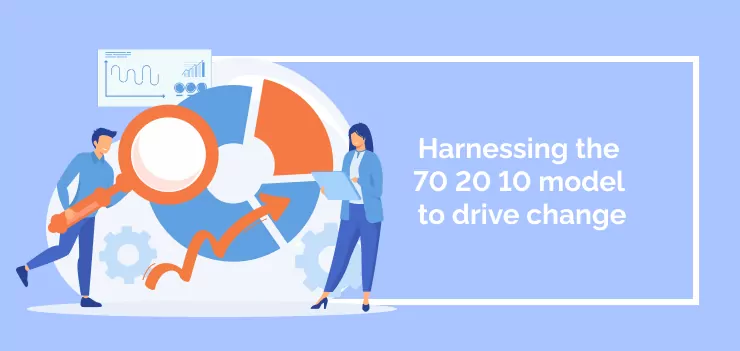
Effective learning and development is a key driver in the need to survive in today’s dynamic business landscape.
According to research by Mckinsey, 60% of executives plan to increase L&D spending over the next few years, and 66% want to boost the number of employee-training hours.
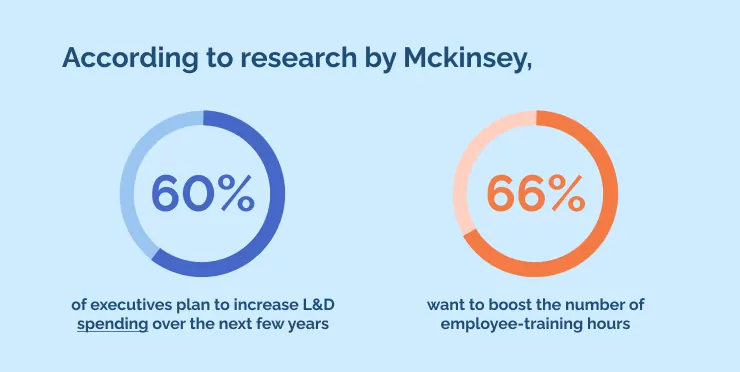
If that’s you, make sure you look before you leap. You don’t want to invest in learning and development only to find that your efforts aren’t impactful.
With that in mind, one model has consistently shown merit: The 70 20 10 model.
Far from a mere passing trend in the learning and development space, the 70 20 10 Model is a proven framework that transforms how organizations approach learning and development.
It’s a learning and development model that suggests a proportional breakdown of how people learn effectively.
- 70% of learning and development takes place from real-life and on-the-job experiences, tasks, and problem-solving
- 20% from feedback, observations, and interactions with others
- 10% from formal educational events
The 70 20 10 model emphasizes the significance of experiential learning and the idea that the most impactful learning occurs at work, during everyday tasks, challenges, and interactions.
The model’s significance extends beyond learning and development, too; it plays an instrumental role in both digital transformation and change management.
Leaders who understand and apply the 70 20 10 model tend to create more inclusive, innovative, and adaptive teams.
And when it comes to change management, the model facilitates a continuous learning environment that encourages adaptability and resilience, making it an essential tool for any business navigating periods of change.
In this article, we’ll delve deeper into the specifics of the 70 20 10 model, its implications for change management, and how to implement this powerful framework in your organization to drive meaningful change and foster a culture of continuous learning.
Understanding the 70 20 10 Model
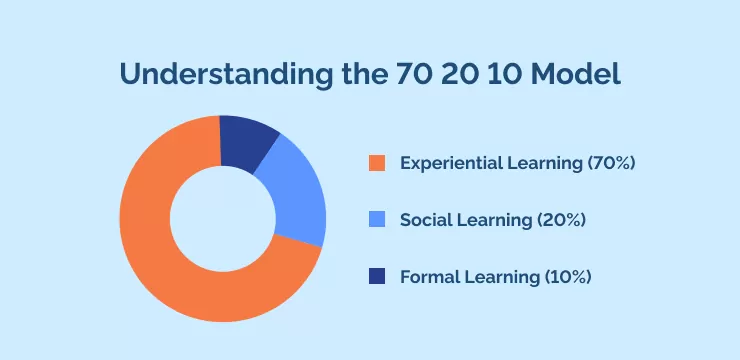
The 70 20 10 model is built upon the understanding that different types of learning opportunities contribute to one’s growth and development in varying proportions.
The model is broken down into three distinct but interconnected areas: experiential learning, social learning, and formal learning.
Let’s break down each of these areas in more detail:
Experiential Learning (70%)
This forms the model’s foundation and is where most effective learning happens according to the 70 20 10 system.
Experiential learning covers on-the-job experiences, tasks and problem-solving, and real-life practice.
It’s about learning by doing. It involves tackling real-world challenges, learning from mistakes, and understanding the nuances of one’s role within the workplace.
Social Learning (20%)
This section emphasizes learning from and with others.
It can be through feedback, observations, interactions, coaching, and mentoring from superiors and peers.
This informal, conversational learning provides a chance to gain insights from others’ experiences and perspectives, enhancing one’s own understanding and broadening the learning horizon.
Formal Learning (10%)
The model assigns the smallest portion of learning to traditional, formal education.
This includes structured educational events such as workshops, courses, seminars, eLearning, and reading.
Despite the small percentage, this is an essential aspect of learning and development, providing foundational knowledge and theoretical underpinnings that guide experiential and social learning.
Why does the 70 20 10 work so well
The beauty of the 70 20 10 model lies in its practical, holistic approach to learning and development.
This model shifts the focus from traditional learning methods that overly rely on formal employee training to a more well-rounded understanding that recognizes the value of real-world experience and interpersonal learning.
The benefits of adopting the 70 20 10 model are considerable:
It mirrors how most people effectively learn, leading to better retention and application of knowledge.
It promotes continuous learning and adaptability, essential skills in today’s ever-changing business world.
It empowers individuals to control their learning, fostering self-reliance and initiative.
And finally, it encourages collaborative learning, cultivating stronger relationships among team members, ultimately leading to improved team performance and communication.
The 70 20 10 Model in change management
Learning is not a luxury in change management but a necessity.
Change challenges the status quo by its very nature, pushing individuals and organizations out of their comfort zones.
Adopting new technology, redefining business processes, or transforming organizational culture— the ability to learn, adapt, and grow is critical to successful change management.
The 70 20 10 model plays a vital role in this arena.
It fosters an environment conducive to continuous learning, resilience, and adaptability— traits essential for managing and driving change.
Implementing the 70 20 10 model in your organization
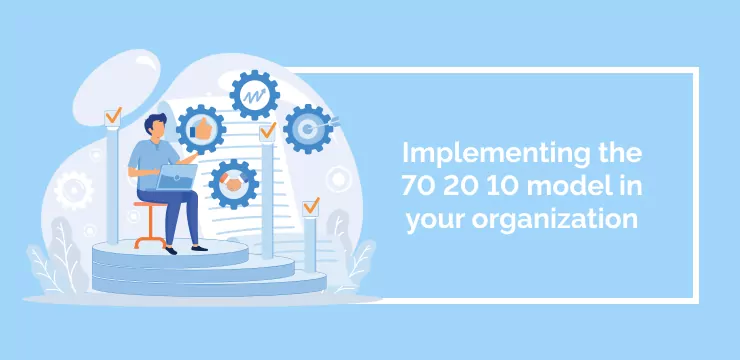
The 70 20 10 model has clear advantages, but how do you effectively implement it within your organization?
Here’s a practical guide on preparing your organization, executing the model, leveraging mentors, and handling potential challenges.
Preparing your organization for the 70 20 10 model
First, you should try to create a culture that values continuous learning.
You need an environment where employees feel at ease tackling new tasks, making mistakes, and learning from those experiences.
Next, ensure your team understands the model’s purpose, advantages, and application.
Your team’s comprehension and acceptance are vital for the model’s successful implementation.
A 5-step guide to implementing the 70 20 10 model
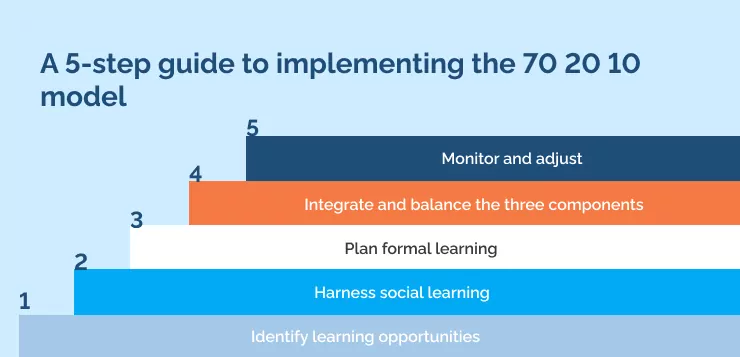
Once your business is primed for it, you can launch into this 5-step guide:
1. Identify learning opportunities
Look for hands-on, on-the-job experiences that align with the skills your team needs to develop.
This could include challenging tasks, job rotations, or leadership roles in a project.
2. Harness social learning
Set up knowledge-sharing platforms like mentoring programs, peer coaching, online discussion forums, and regular feedback sessions.
3. Plan formal learning
Pinpoint where formal education is required and organize relevant educational events.
These might be e-learning courses, workshops, or seminars.
4. Integrate and balance the three components
Ensure the 70% experiential, 20% social, and 10% formal learning components are well-integrated and that one doesn’t overshadow the others.
The aim is to maintain a balance where all three components complement each other.
5. Monitor and adjust
Regularly review the learning experience, ask for feedback, and make necessary changes.
Remember, learning is an ongoing process, and your model should be adaptable to meet evolving needs.
The role of mentors and leadership in the 70 20 10 model
Leaders and mentors are key to successfully applying the 70 20 10 model.
Leaders should set an example by showing their commitment to learning and development. They should also provide their team members with experiential and social learning opportunities.
Mentors facilitate social learning by sharing valuable insights and feedback, encouraging learners to reflect on and learn from their experiences.
Addressing potential challenges and solutions
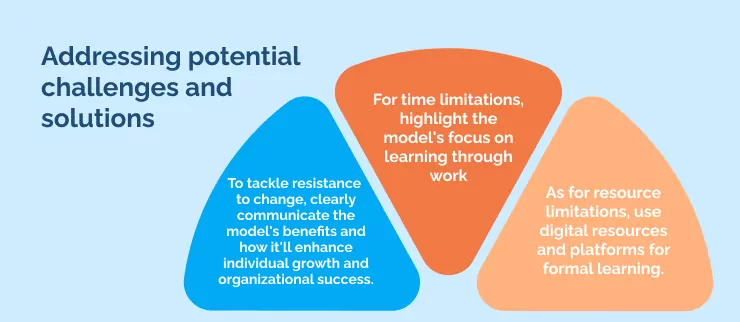
Implementing the 70 20 10 models can come with challenges, like resistance to change, time constraints, or resource limitations for formal learning opportunities.
To tackle resistance to change, clearly communicate the model’s benefits and how it’ll enhance individual growth and organizational success.
For time limitations, highlight the model’s focus on learning through work— most learning happens on the job, not outside it. Encourage your team to see new tasks and challenges as learning opportunities.
As for resource limitations, use digital resources and platforms for formal learning. Make use of online training, webinars, and workshops.
With careful planning, transparent communication, and strong leadership, you can successfully implement the 70 20 10 model, fostering a dynamic learning culture within your organization.
Measuring success with the 70 20 10 model
You’ll need to establish a system for measuring success to ensure the effective implementation of the 70 20 10 models.
Don’t skip this step— you want to know what kind of impact you’re having on your business.
That means setting key performance indicators (KPIs), using analytics to track progress, and sharing success stories to motivate continued commitment to the model.
Key performance indicators to gauge success
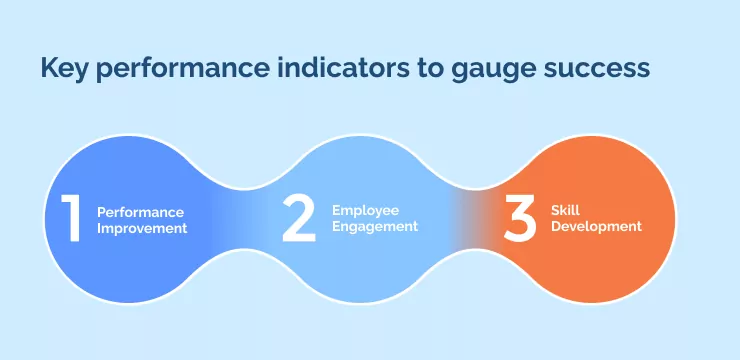
KPIs can provide quantitative evidence of how well the 70 20 10 model works in your organization. Some KPIs you might consider include:
- Performance Improvement: Are employees performing better after the implementation of the model? You can measure this through sales figures, customer satisfaction scores, or project delivery times.
- Employee Engagement: Are employees more engaged? Employee surveys can give insights into whether your team feels motivated, satisfied, and invested in their work.
- Skill Development: Are employees gaining new skills? This can be tracked through assessments, employee feedback, and observation of work performance.
Using data analytics to track progress
A data-driven approach can also help you track the effectiveness of the 70 20 10 model.
You can analyze data from various sources, including training records, performance metrics, and employee feedback, to comprehensively understand your learning initiatives’ impact.
Analytics can also help you identify areas of strength and areas that may require more attention or adjustment.
Sharing success stories to shape culture slowly
Sharing success stories can be a potent tool for promoting the model’s effectiveness.
These stories can showcase how the model has improved performance, enhanced skills, and increased employee experience. They also serve as inspiration for the continued commitment to the model.
Sharing success stories reinforces the value of the 70 20 10 models and helps create a culture of learning and growth within your organization.
Regularly evaluating your progress and celebrating your successes foster a continued commitment to the model and, more importantly, to the underlying philosophy of continuous learning and development.
The 70 20 10 Model: Because sometimes simple solutions are best
We’ve explored the fundamental aspects and benefits of the 70 20 10 model, its crucial role in business leadership and change management, and how you can effectively implement it in your organization.
The 70 20 10 model is more than just a learning framework— it represents a holistic personal and professional development approach.
It emphasizes the importance of hands-on experience, social interactions, and formal education, creating a dynamic and versatile learning environment.
As you move forward, remember that implementation isn’t a one-off task but a journey.
There may be hurdles, but with a strategic approach, clear communication, strong leadership, and commitment to continuous improvement, you can successfully embed the 70 20 10 model into your organization’s DNA.
WalkMe Team
WalkMe spearheaded the Digital Adoption Platform (DAP) for associations to use the maximum capacity of their advanced resources. Utilizing man-made consciousness, AI, and context-oriented direction, WalkMe adds a powerful UI layer to raise the computerized proficiency, everything being equal.



